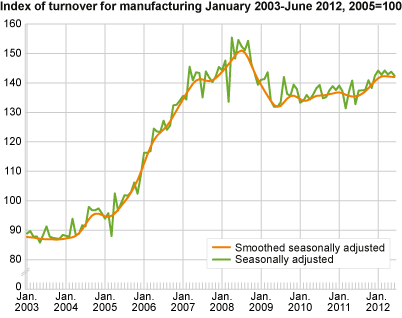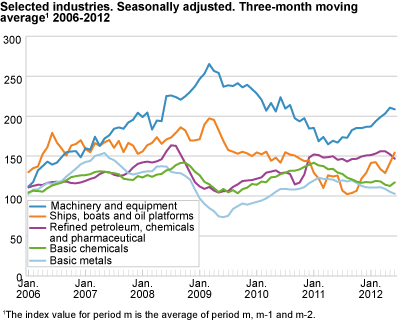Content
Published:
This is an archived release.
Unchanged industrial turnover
Seasonally-adjusted figures showed that the total turnover in Norwegian manufacturing had a slight fall of 0.5 per cent from the first quarter of 2012 to the second quarter the same year.
The grouping refined petroleum, chemicals and pharmaceutical fell by 5.9 per cent. This was mainly due to a price fall within refined petroleum products, see the Producer price index .
Among industries with increased turnover in the second quarter of 2012 were building of ships, boats and oil platforms, rising 15.5 per cent. Machinery and equipment rose as well, by 4.9 per cent. Higher production levels in both groupings in this period are the reason behind this development, see the index of production . Enhance in production levels are the result of high investment levels within the oil and gas sector.
Small decrease in turnover from May to June
Seasonally-adjusted figures showed that total Norwegian manufacturing turnover went down by 0.9 per cent from May to June 2012. Building of ships, boats and oil platforms had a significant drop in turnover, but this is mostly an adjustment from the very high turnover in May, when several large deliveries took place.
Industries with positive results were basic metals, up 8.4 per cent and fabricated metal products rising 5.8 per cent.
Increase from June 2011 to June 2012
Unadjusted figures showed an increase of 6.5 per cent in total manufacturing turnover in June 2012 compared to June 2011. Building of ships, boats and oil platforms had the largest growth in turnover, up 35.3 per cent. Also machinery and equipment increased, here by 23.9 per cent. This was followed by computer and electrical equipment, with an increase of 11.2 per cent.
Industries with reduced turnover were basic metals as well as the grouping repair, installation of machinery. Both went down by 5.9 per cent from June 2011 to June 2012.
|
Original series.1 January-June 2012 |
Changes in per cent.
January-June 2011- January-June 2012 |
Original series.1 June 2012 |
Changes in per cent.
June 2011-June 2012 |
Changes in per cent.
Seasonally adjusted. January 2012-March 2012- April 2012-June 2012 |
|||||||||||||||||||||||||||||||||||||||||||||||||||||||||||||||||||||||||||
|---|---|---|---|---|---|---|---|---|---|---|---|---|---|---|---|---|---|---|---|---|---|---|---|---|---|---|---|---|---|---|---|---|---|---|---|---|---|---|---|---|---|---|---|---|---|---|---|---|---|---|---|---|---|---|---|---|---|---|---|---|---|---|---|---|---|---|---|---|---|---|---|---|---|---|---|---|---|---|---|
| The overall turnover | 845 959 | 9.1 | 131 046 | 8.0 | -0.5 | ||||||||||||||||||||||||||||||||||||||||||||||||||||||||||||||||||||||||||
| Extraction and related services | 386 191 | 21.2 | 53 354 | 14.6 | -3.2 | ||||||||||||||||||||||||||||||||||||||||||||||||||||||||||||||||||||||||||
| Manufacturing, mining and quarrying | 400 199 | 6.4 | 70 400 | 7.1 | -0.2 | ||||||||||||||||||||||||||||||||||||||||||||||||||||||||||||||||||||||||||
| Domestic market | 239 994 | 8.6 | 43 977 | 11.1 | -0.5 | ||||||||||||||||||||||||||||||||||||||||||||||||||||||||||||||||||||||||||
| Export market | 160 205 | 3.4 | 26 423 | 1.0 | -2.0 | ||||||||||||||||||||||||||||||||||||||||||||||||||||||||||||||||||||||||||
| Electricity, Gas and Steam Supply | 59 568 | -26.4 | 7 291 | -19.2 | 6.0 | ||||||||||||||||||||||||||||||||||||||||||||||||||||||||||||||||||||||||||
| Main industrial groupings | |||||||||||||||||||||||||||||||||||||||||||||||||||||||||||||||||||||||||||||||
| Intermediate goods | 189 165 | 4.9 | 35 196 | 6.1 | -1.7 | ||||||||||||||||||||||||||||||||||||||||||||||||||||||||||||||||||||||||||
| Capital goods | 112 597 | 14.8 | 19 923 | 17.0 | 3.0 | ||||||||||||||||||||||||||||||||||||||||||||||||||||||||||||||||||||||||||
| Consumer goods | 96 037 | 3.5 | 16 509 | 4.0 | -0.8 | ||||||||||||||||||||||||||||||||||||||||||||||||||||||||||||||||||||||||||
| Energy goods | 448 159 | 10.8 | 59 417 | 7.6 | -2.7 | ||||||||||||||||||||||||||||||||||||||||||||||||||||||||||||||||||||||||||
| 1 | NOK million. |
Interpretation of seasonally-adjusted figuresIn order to facilitate the interpretation of the short-term development, statistics on turnover publishes three-month moving averages of the seasonally-adjusted figures. We normally compare the latest non-overlapping three-month periods (for instance January to March compared with April to June). The relationship between production and turnoverThe development in the turnover can be related to changes in both volume and prices in the different industries. Production to stocks and sales from stocks can also take place. Reporting of large deliveries of capital goods can contribute to differences in the development in the index of production and the statistics on turnover. |
Find more figures
Find detailed figures from Turnover in oil and gas, manufacturing, mining and electricity supply
Additional information
The variation in manufacturing turnover can be related to changes in volume and price indices in different industries and also production to stocks and sales from stocks.
Contact
-
Robert Skotvold
E-mail: robert.skotvold@ssb.no
tel.: (+47) 40 90 24 44
-
Anne Karin Linderud Haugen
E-mail: anne.karin.linderud.haugen@ssb.no
tel.: (+47) 91 88 19 76


